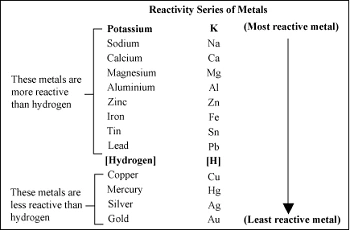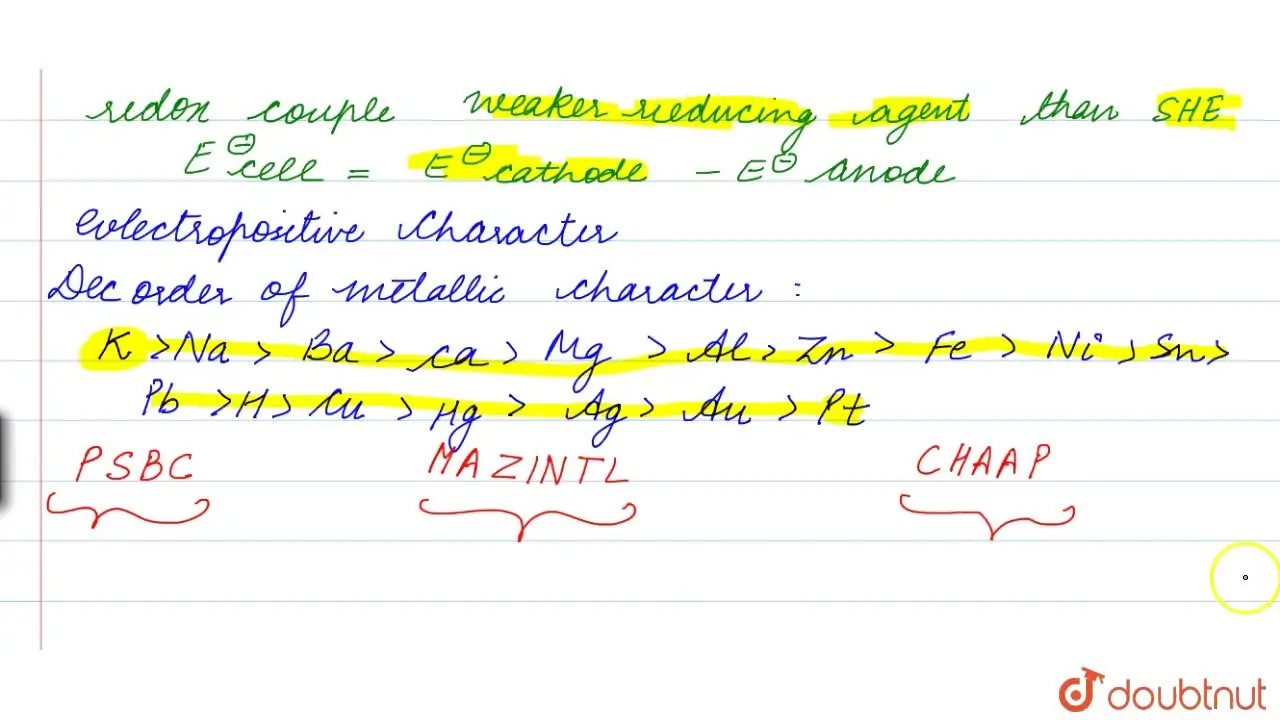Electrochemical Series
Electrochemical Series
The electrochemical series, otherwise called the activity series, is a list of metals arranged by diminishing reactivity or arranged by diminishing ease of oxidation.
The metals at the highest point of the series, for example, the alkali metals and the alkaline earth metals, are more reactive or are most effortlessly oxidised than the metals found at the base of the series. This fundamentally implies they can react all the more effectively to form chemical compounds. These particular metals that are at the top of the electrochemical/activity series are called active metals.
The metals at the base of the electrochemical series, for example, the transition metals, are truly steady and stable. They form chemical compounds less readily. These metals, for example, copper and gold, are utilised to make coins and adornments and are called noble metals owing to their low reactivity. The metals in the electrochemical series are placed according to their standard electrode potentials.
Electrode potential is the electric potential of a cell having an electrode behaving as a cathode and the standard hydrogen anode (SHE) going about as the anode. Reduction occurs at the cathode, and oxidation takes place at the anode.
The electrochemical series can be utilized to anticipate the results of reactions among metals and either metal acids or salts. The ions of the particular elements (to be discussed below) can oxidise metals.

Some Application of Electrochemical Series
1. Determination of Standard EMF (E0) of an Electrochemical Cell
The Eo of the cell is the sum of the standard reduction potential: oxidation half cell and reduction half cell
Eocell = Eooxidation + Eoreduction
Eooxidation is always represented as reduction potential.
Thus, Eooxidation = – Eoreduction
It implies,
Eocell = ( Eoreduction of reduction half cell) – ( Eoreduction of oxidation half cell)
When oxidation occurs at anode and reduction occurs at the cathode.
Thus, Eocell = Eocathode – Eoanode
Example:
Consider a reaction, 2Ag+ + Cd → 2Ag + Cd+2(aq)
Eoreduction is expressed as: Ag+/ Ag = 0.80 volt, Cd+2/ Cd = - 0.40 volt
From the reaction, we can deduce that Cd losses electron and Ag+ accepts. So, oxidation half cell or anode is Cd.
We know, Eocell = Eocathode – Eoanode
=0.80 -(-0.40)
= 1.20 volt
2. To predict the relative oxidizing and reducing powers
The electrochemical series assists with selecting substances that are effective oxidizing species and those which are good reducing agents. In an electrochemical series, the species which are set above hydrogen are progressively hard for reduction and their standard reduction potential qualities are negative.
The Li : Li+ (aq) cathode has the least Eo number and along these lines, it is reduced with more efforts. Thusly, Li+ can't gain electrons readily; it loses electrons to act as a reducing species. Lithium is the strongest reducing agent.
3. Predicting the Feasibility of Redox Reaction
Any redox reaction would occur spontaneously if the free energy change (ΔG) is negative. The free energy is related to cell emf in the following manner:
ΔGo = nFEo
Where n represents the number of electrons engaged in the reaction, F denotes the Faraday constant and Eo is the cell emf.
- In the case when Eo is positive, the cell reaction is spontaneous and serves as a source of electrical energy.
- if Eo is positive, then ΔGo can be negative.
- If it comes out to be negative then the spontaneous reaction cannot take place.
- The resultant value of Eo for redox reaction is important in predicting the stability of a metal salt solution when stored in another metal container.
Examples
1. Determine whether the reaction will occur spontaneously:
Fe+3 + 2Cl– → Fe+2 + Cl2
E0Cl / Cl –= 1.36 volt
E0Fe+2/Fe = -0.440 volt
Sol-
Eocell = Eocathode – Eoanode
Since chlorine has higher reduction potential than iron therefore at cathode reduction of chlorine occurs and oxidation of iron occurs at the anode.
Eocell = 1.36 -(-0.440) = 1.80 volts
The positive value of E0Cell implies that reaction occurs spontaneously.
2. The standard reduction potential at 250C for the half-reaction are mentioned
Fe+3 + e– → Fe+2 ; 0.77 volt
Cr+3 (aq) + 3e–→ Cr(s); -0.740 volt
Zn+2(aq) + 2e– → Zn(s); -0.76 volt
Cu+2(aq) + 2e– → Cu(s); 0.34 volt
Which is the strongest reducing agent
- Fe+3
- Cr
- Zn
- Cu
Sol- Zn
As we know, reducing agent tends to lose electron, so it is oxidised. Out of the given half-reaction, the reduction of Zn+2 has the lowest reduction potential(-0.762). We know that
Oxidation potential = -(reduction potential)
With regard to standard oxidation potential, Zinc will have the highest oxidation potential (0.762 volts). Therefore, zinc is the strongest reducing agent.
3. The standard oxidation potential, E0 for the half-reactions are as follows,
Fe → Fe+2 + 2e– ; E0 = 0.41 volt
Cu → Cu+2 + 2e– ; E0 = -0.34 volt
Find the emf, Cu+2 + Fe → Cu + Fe+2
Sol-
Eocell = ( Eoreduction of reduction half cell) – ( Eoreduction of oxidation half cell)
Eocell = -( Eooxidation of reduction half cell) – (-Eooxidation of oxidation half cell)
Eocell = -0.34-(-0.41)
Eocell = 0.07 volt.

Similar Questions
From the electrochemical series given in the text, determine the approximate value of E∘ for X2+(aq)+2e→X(s)
The metal X dissolves in nitric acid but not in hydrochloric acid . It can displace Ag+ but not Cu2+View SolutionThe position of some metals in the electrochemical series in dectreasing electropositeve character is given as Mg<Al>Zn>Cu>Ag. What will happen if a copper spoon is used to stir a solution of aluminimum nitrate ?
View SolutionThe position of some metals in the electrochemical series in dectreasing electropositeve character is given as Mg>Al>Zn>Cu>Ag. What will happen if a copper spoon is used to stir a solution of aluminimum nitrate ?
View SolutionThe position of some metals in the electrochemical series in decreasing electropositive character is given below:
Mg > Al> Zn > Cu > Ag
What will happen if a copper spoon is used to stir a solution of aluminium nitrate?View SolutionFrom the electrochemical series given in the text, determine the approximate value of E∘ for X2+(aq)+2e→X(s)
The metal X dissolves in hydrochloric acid producing H2 but does not replace either Zn2+orFe2+.View SolutionMost metal oxide are thermally stable at temperature upto 1000∘C but the oxide of metals below hydrogen in the electrochemical series fairly. Thus HgOandAg2O decomposes on heating.
Q. Which of the following compound cannot be thermally decomposed even at high temperature?View SolutionMost metal oxide are thermally stable at temperature upto 1000∘C but the oxide of metals below hydrogen in the electrochemical series fairly. Thus HgOandAg2O decomposes on heating.
Q. Which of the following compound cannot be thermally decomposed even at high temperature?View SolutionMost metal oxide are thermally stable at temperature upto 1000∘C but the oxide of metals below hydrogen in the electrochemical series fairly. Thus HgOandAg2O decomposes on heating.
Q. Which of the following salt salt does not give NO2 gas on heating?View SolutionElectrochemistry|Electrochemical Cell|Construction Of Electrochemical Cells|Representation Of Cell|OMR
View Solution


